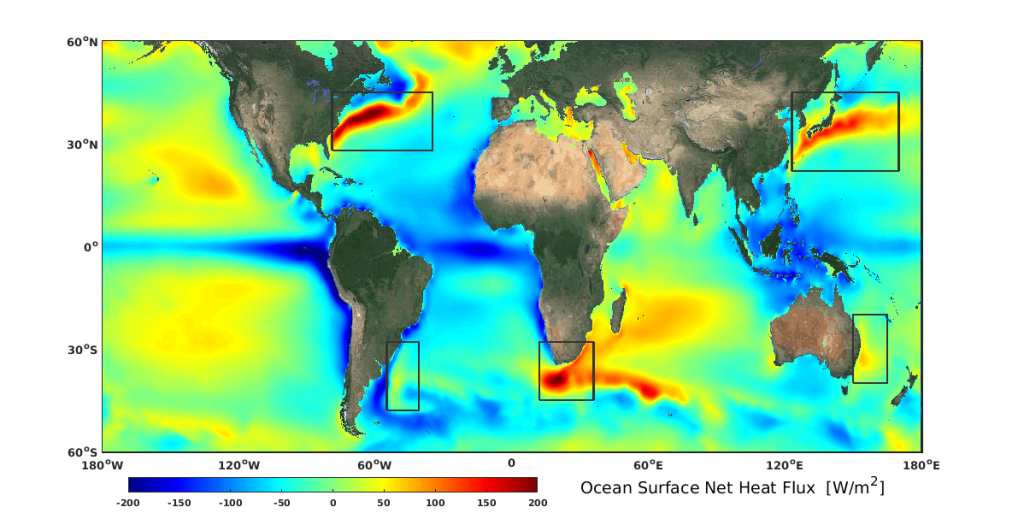博文
[转载]oceanic boundary currents to i...
||
Climate change causing oceanic boundary currents to intensify and shift poleward
Change means greater heat and more winter storms for Asia; Gulf Stream is the exception
by Sina Löschke and Lauren Lipuma
Weather along the eastern coasts of South Africa, Asia, Australasia and South America will get significantly warmer and stormier on average over the next 100 years, a new study finds. The culprit? Climate changes that are causing ocean currents next to these coastal regions, called western boundary currents, to become stronger and extend further toward the poles, according to the new study.
Western boundary currents move warm water from the tropics toward the poles. Driven by winds, they occur on the western edges of oceans, adjacent to the eastern coasts of continents. They extend down to a depth of 1,000 meters (3,000 feet) and are among the fastest ocean currents in the world.
The Gulf Stream is the North Atlantic Ocean’s western boundary current, carrying warm water from the Gulf of Mexico northward up the Atlantic coast of the U.S. and Canada. Other western boundary currents include the Kuroshio Current off the coast of Japan, the Brazil Current off the eastern coast of South America, the Eastern Australia Current and the Agulhas Current off the coast of South Africa.
In the new study, scientists from the Alfred Wegener Institute (AWI) Helmholtz Centre for Polar and Marine Research in Bremerhaven, Germany used oceanographic and satellite data from 11 independent climate databases to evaluate how western boundary current changed from 1958 to 2001. They also analyzed simulations of past and future climates, indicators of the currents’ flow speeds, water temperature and air pressure at the ocean surface.
The researchers found increasing winds in both the Northern and Southern Hemispheres are causing western boundary currents to get warmer, stronger, and extend poleward. The study was published today in the Journal of Geophysical Research: Oceans, a journal of the American Geophysical Union.
This image shows the annual mean net heat flux from the ocean surface to the atmosphere at five major western boundary currents: The Gulf Stream off the eastern coast of North America, the Brazil Current off the eastern coast of South America, the Kuroshio Current off the coast of Japan, the Eastern Australia Current and the Agulhas Current off the coast of South Africa. New research finds the western boundary current (with the exception of the Gulf Stream) are becoming stronger due to climate change.
Credit: Alfred Wegener Institute/Hu Yang.
“Our analysis shows that the surface temperature of the boundary currents has increased two to three times faster than in other oceanic regions,” said Hu Yang, a climate scientist at AWI and co-author of the study. “In addition, the currents release at least 20 percent more heat than they did half a century ago, which leads to the conclusion that the temperature of the water has risen, its flow speed has increased and the currents thus transfer more water and also more heat from the tropics towards the pole.”
The greater the heat transfer from the sea, the higher the probability of storms in those areas, according to the researchers. “Over the next [few] decades, Japan, China and Korea will need to expect higher air temperatures particularly in winter, because the Kuroshio Current will transport more heat and shift northward with the wind,” said Gerrit Lohmann, climate scientist at AWI and co-author of the study. “This heat will change the atmospheric condition in such as way as to make storms more likely in this region. For the Eastern Australian Current, the Brazil Current and the Agulhas Current on the southern hemisphere, our analyses predict a southward shift, because there, too, the winds shift poleward,” Lohmann said.
The Gulf Stream will become weaker
Warmer, stronger, poleward – the new study finds this pattern applies to all western boundary currents with one exception: the Gulf Stream. “All of our results predict its long-term weakening,” Lohmann said. The reason for this is the Gulf Stream is driven not only by wind, but also by changes in the ocean thermohaline circulation, which moves water all over the globe based on its temperature and salinity. “This is often referred to as a global conveyor belt,” Lohmann said. “Our results indicate that the power of this conveyor belt will weaken in the long term, and in an order of magnitude that more than compensates for the plus of increasing winds. Without the influence of this circulation, the Gulf Stream would follow the same patterns as the other boundary currents.”
The climate scientists also fear far-reaching consequences for the fauna and flora of the affected coastal regions. “As these currents bring higher temperatures to these temperate latitudes, while advancing further north or south, many species will be forced to move to colder regions,” Lohmann said. “But some of them won’t be able to face this challenge.”
https://agupubs.onlinelibrary.wiley.com/doi/full/10.1002/2015JC011513

https://blog.sciencenet.cn/blog-39359-1207080.html
上一篇:[转载]深海热泉生物利用热辐射进行光合作用 2005年
下一篇:[转载]UNESCO technical papers in marine science
